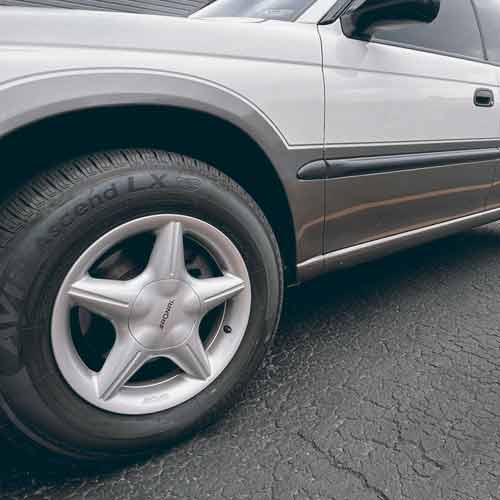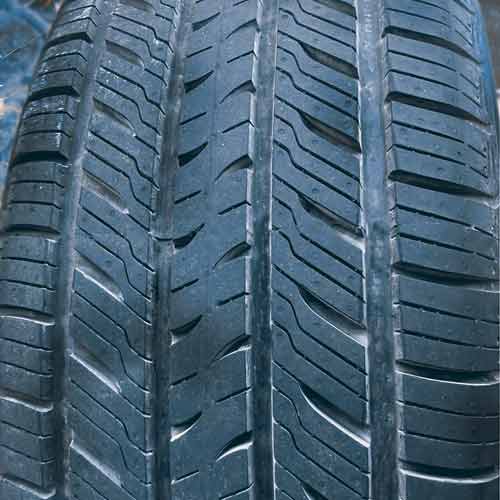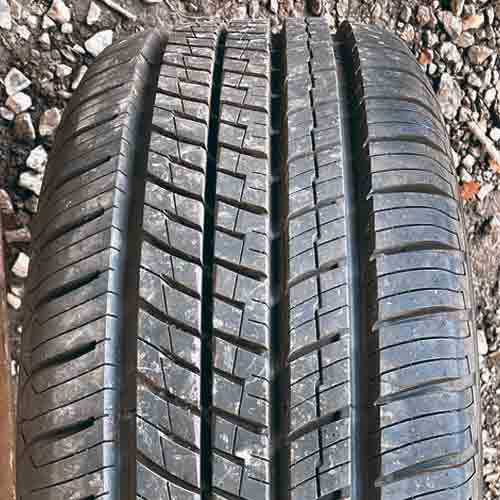The Yokohama Avid Ascend GT is the grand touring tire, crafted for those who seek a blend of comfort, durability, and performance on varied conditions. On the other hand, the Avid Ascend LX is the standard touring tire, focusing on reliability, fuel efficiency, and a quiet, comfortable ride for everyday use. Let’s see which tire suits you better.

Table of Contents
Key Takeaway
The Yokohama Avid Ascend GT is better at:
- Wet traction and hydroplaning resistance.
- Winter braking, acceleration, and cornering.
- Smoother ride over bumps.
Detailed Discussion on Ascend GT: https://tiredriver.com/yokohama-avid-ascend-gt-review/
While the Avid Ascend LX is better at:
- Dry performance and braking.
- Longer tread life and fuel economy.
- Reducing tire noise.
Tread Pattern
The Avid Ascend LX sports a symmetrical tread pattern, typical of standard touring tires.

Let’s first talk its 3 ribs (or block columns) in the middle, forming four circumferential grooves in conjunction with the shoulders…
Here, the central most one is continuous running and is equipped with sharp, bidirectional notches and linear sipes.
The adjacent ribs, although are also “continuous-running”, feature more pronounced notches and siping.
These slanted notches face the shoulders, which are actually very similar to the Ascend GT.
These shoulder blocks have proper (and prominent) lateral voids and straighten-up sipes.
And yes, they also have rounded outer edges, which aids steering responsiveness.
Moving towards the Yokohama AVID Ascend GT, this tire is distinguished by a 5-rib, asymmetrical tread design.

Among these, the three central ribs contribute to the tire’s four circumferential grooves. though they vary in width for enhanced performance.
Two of these central ribs are particularly alike, each reflecting the other’s design with chamfered edges, notches, and a mix of linear lateral and longitudinal sipes.
In contrast, the third rib stands out with its unique combination of longitudinal slits and lateral siping, offering a distinct tread feature.
The shoulder lugs on both sides are nearly identical, marked by in-groove notches and linear lateral siping, contributing to the tire’s grip and stability.
Internally, the tire offers robust construction, featuring a single-ply polyester casing and dual wide steel belts, all underpinned by a comprehensive nylon cap ply.
Though a similar internal construction is seen on the Ascend LX (at-least on the paper).
Sizes – What To Know?
| Specs | Avid Ascend GT | Avid Ascend LX |
|---|---|---|
| Rim Sizes | 15 to 20 inches | 15 to 18 inches |
| Speed Ratings | H and V | T, H, and 4 sizes with V |
| Load Ratings | SL and XL | SL and XL |
| Tread Depth | 12/32″ on all | 11/32″ on all |
| Weight Range | 17 to 32 lbs | 18 to 30 lbs |
| Warranty | 65k miles | 85k miles |
| UTQG Rating | 740 A A | 600 to 800 A A |
Dry Performance
I the world of dry performance, there are 3 essential elements to consider: directional grip (also called braking), lateral grip and steering response. Let’s take a look at them all.
Directional Grip
Directional or braking grip is the traction of a tire when it rolls straight. And let me tell you, the Yokohama Avid Ascend LX tire is a standout performer here.
From what I’ve seen in my own tests, the LX consistently pulls up shorter than its counterpart, the GT. We’re talking about an average of a foot less in braking distance, which is pretty significant.
Now, the secret sauce for the LX’s performance is its slick rib design. It’s got this unbroken structure running through it, which ensures the tire maintains a steady/consistent contact with the road, enhancing longitudinal traction.
On the other hand, the Avid Ascend GT doesn’t quite hit the same mark. The main issue here? It’s got this somewhat patchy space right in the middle rib.
But why this middle area matters here? Well, this is because its where most of the weight (on the tire) gets concentrated. In other words, this area meets the road, the most.
Now, sure, the Avid Ascend GT tries to make up for it, with in-groove notches (biters) meant to increase grip. But, honestly, they’re doing more harm than good here.
What I mean is that, by taking away some of the rubber, these notches reduce the tire’s contact patch with the road, which in turn, dials down the grip, even though they provide increased biting edges.
Dry Handling
Cornering can be categorized into three distinct stages: the entry, mid-corner, and exit phases.
- During the entry phase, effective braking and downshifting are crucial for a smooth, slip-free approach to the corner.
- The mid-corner phase requires precise and responsive steering to maintain control and trajectory.
- The exit phase is characterized by the vehicle straightening and reintroducing acceleration.
Having said that, the Avid Ascend LX thrives in all these aspects, where it offers superior braking capabilities, thanks to its refined design, allowing for faster corner entry.
Additionally, its shallower tread depth and lighter build provide enhanced mid-corner feedback, offering a clear indication of available grip. Thus, it outperforms in the remaining two phases as well.
Conversely, the Yokohama Avid Ascend GT falls short of the LX’s dynamic prowess, evidenced by its comparatively slower lap times in my tests and lackluster handling.
The primary drawback of this tire is its lethargic on-center feel, notably affecting its performance during corner exit.
And this necessitates a cautious approach when accelerating post-corner, (to avoid slippage, drifting), as it lacks the sharp, immediate feedback essential for confident acceleration.
Wet Performance
How a tire performs on wet surfaces depends largely on its tread’s water evacuation capabilities, underscoring the importance of wet traction and hydroplaning resistance. Let’s get into each of these areas one by one.
Wet Grip
Wet traction in tires is significantly influenced by sipes, which are small cuts in the tire tread.
These seemingly modest features (sipes) play a crucial role by creating suction to draw moisture away from the lugs, enabling the tire’s rubber to grip effectively on damp surfaces.
That’s why for optimal wet traction, a tire requires numerous, flexible sipes, as their “quantity” and “pliability” determine their effectiveness (of throwing water away at a micro scale, while majority leaves out through grooves).
In this context, the Yokohama Avid Ascend LX is lacking. I mean on my tests, it consistently lacked (in all sizes I picked out), showcasing longer braking distances and wet handling lap times.
So, why is that?
Well, this is primarily due to its less flexible rubber composition that restricts the sipes’ ability to effectively wick away moisture.
Conversely, the Yokohama Avid Ascend GT excels in wet traction, attributable to several key features:
- Abundant Siping: It offers a higher count of sipes compared to the LX, enhancing its ability to clear water more efficiently.
- Slick Siping Style: It’s got these straight sipes on the edges and wavy ones in the middle, making for a super effective water-shifting setup, (as such design stay flexible, even during harsher maneuvers).
- Interconnected Grooves: The GT’s grooves are more intricately interlinked, facilitating better water ejection. This basically reduces the reliance on sipes by initially removing more water from the tread surface.
All in all, these features make the Avid Ascend GT a bit of a superstar in the wet, showing up the LX in the process. And yes, its not really that surprising, given that its a grand touring all-season tire, (while the LX is standard touring).
Learn more here: Different types of all-season tires.
Aquaplaning Resistance
Hydroplaning is like when your tire decides to go surfing on water instead of sticking to the road. And this happens when it can’t shove the water out of the way fast enough, and instead, it just skims on top.
Now, of course, to dodge this, tires have these wide channels called grooves that help sling water out of the way.
And here, the Yokohama Avid Ascend GT is taking the lead. This is because the tire has interconnected grooves that run around the tire and a slightly open shoulder design.
And together, along with greater tread depth, the take out more water compared to LX variant.
Speaking of which, the Ascend LX lacks with its continuous-running and unbroken ribs that kind of put a damper on moving water sideways.
Ice and Snow Performance
Both these guys, the Yokohama Avid Ascend GT and LX, like to boast about their all-season prowess, even in winter conditions, despite not having the 3-Peak Mountain Snowflake (3PMSF) certification.
This certification is pretty much the gold standard for winter tire performance, indicating a tire’s capability to handle severe snowy conditions.
Learn more on this rating here: https://tiredriver.com/3pmsf-and-ms-ratings/
Now, even without this coveted badge, both tires hold their own pretty well.
Yet, it’s the Yokohama Avid Ascend GT that really takes the spotlight, as it excels in all of the three crucial areas of winter driving: braking, acceleration, and cornering.
Its star feature? The tire’s knack for maintaining higher speeds in turns, showcasing its superior lateral traction and steering responsiveness.
On the flip side, the Yokohama Avid Ascend LX, although lacks here, its performance is still appreciable, given its a standard touring tire. In fact I rated this tire for it, in my list of best standard touring all-season options.
I mean its really good in light snow, thanks to its multi-directional biting edges, or in-groove notches which traps snow in effectively.
This is key, because snow tends to stick to itself better than it does to rubber, giving you that extra grip when you need it most.
Tread Life and Fuel Economy
Discussing fuel efficiency and tire longevity, the key factors are rolling resistance and heat generation. And the tire’s weight, tread design, and rubber composition play pivotal roles here.
For the Avid Ascend GT, its softer rubber compound and heavier construction contribute to increased rolling resistance, leading to higher fuel consumption. Essentially, these elements cause the tread lugs to bend more, dissipating energy as heat, which isn’t ideal for fuel economy.
Furthermore, despite having a 1/32″ deeper tread depth, the GT falls short in tread life. Its softer rubber wears down to the 2/32″ legal tread depth limit more quickly than one might expect.
This explains why the LX offers a 20,000-mile greater treadwear warranty in comparison here.
Overall Ride Comfort
A comfortable drive hinges on two vital components: the tread noise of the tire and the tire’s ability to soften the blow from uneven road surfaces. Let’s dissect each component in detail.
Noise Comfort
Tire noise primarily originates from the interaction of air particles with the tire’s tread blocks. These particles enter through the shoulder blocks and create noise as they collide against the tread walls.
This initial noise then echoes within the tire’s cavity, a phenomenon influenced by the rubber’s composition and known as in-groove resonance.
So, it’s no wonder the Yokohama Avid Ascend GT is on the noisier side. Its design has bigger gaps, especially around the shoulders and sidewall areas, which means more air gets in and does its noisy dance inside the tread pattern.
Plus, the tire’s softer rubber makes this in-groove resonance even louder.
In contrast, the Yokohama Avid Ascend LX employs a different approach to mitigate noise. By incorporating ridges between the shoulder blocks, it disrupts the pathway of air particles, thereby reducing noise at the source.
Additionally, the rubber composition of the LX is optimized for better pitch sequencing, a sophisticated tread configuration. This design creates sound waves of varying wavelengths and frequencies that interfere with each other, effectively reducing the overall tire noise.
Road Smoothness
The Yokohama Avid Ascend GT really shines when it comes to vibration comfort, which boils down to how well a tire can smooth out road bumps while keeping the ride stable.
While everyone has their own take on what feels comfy, in my experience, the Ascend GT tends to deliver a ride that many would find quite pleasant, especially when you stack it up against the LX.
This viewpoint comes from my hands-on (subjective) evaluations/testing, where I’ve checked out how the tires handle both minor and major road flaws, including those pesky cracked surfaces.
So, what gives the GT its edge in comfort? It’s largely thanks to its internal build, where it’s decked out with an extra layer of polyester cap ply, which really steps up its game in absorbing those jolts and judders from the road.
To Conclude
Speaking of Ascend GT first. While its lateral grip and steering response also impress, it’s the LX’s superior handling through all cornering phases that truly stands out.
On the wet front, though, the GT takes the lead, especially with its siping and groove design enhancing traction and hydroplaning resistance.
And same is the case for winter conditions, where the GT offers higher speeds and ensuring better grip.
However, in terms of tread life and fuel economy, the GT’s softer rubber and heavier build increase rolling resistance and decrease longevity, whereas the LX offers a longer treadwear warranty, highlighting its durability.
Noise and ride comfort see the LX mitigating noise more effectively and the GT providing a smoother experience over bumps.